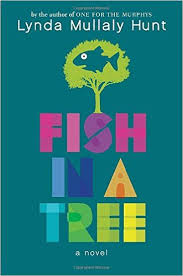Fish in a Tree. Lynda Mullaly Hunt. 2015. Penguin.
Note: Fish in a Tree is the 2015 Global Read Aloud selection.
Grades: 4–6
Summary
 “Seven schools in seven years, and they’re all the same.”
“Seven schools in seven years, and they’re all the same.”
Sixth grader Ally works very hard to keep a secret, even landing herself in the principal’s office repeatedly rather than explaining what she’d rather hide. At the start of the novel, Ally doesn’t know that she has dyslexia. All she knows is that letters dance on the page, dark words on white paper make her head ache, and even a simple homework assignment takes hours to complete. Certain that no one can help her, Ally remains silent about her struggle and believes the words she hears from her classmates: “Freak. Dumb. Loser.”
When Ally’s teacher Mrs. Hall goes on maternity leave, Mr. Daniels steps in. Dubbing his students “Fantasticos,” Mr. Daniels soon demonstrates his knack for seeing each student’s unique gifts. Though the road is sometimes rocky, Ally begins to trust her new teacher and his offer of help.
Mr. Daniels shows Ally that she has value in their classroom community, and her confidence increases. Armed with skills to begin coping with her dyslexia, and joined by friends Keisha and Albert, Ally learns that she can not only survive sixth grade but also thrive as she starts to find happiness and “a special Ally-shaped place in the world.”
Cross-Curricular Connections
English/language arts, social studies/history, science
Ideas for Classroom Use
“My very educated mother just served us nachos.”
Many of us grew up learning the planets via a mother who served “nine pizzas,” not “nachos.” Pluto may no longer be a planet, but the recent New Horizons fly-by has proven that—like Ally—it may be different but it certainly not less than. Explore this rockstar dwarf planet to gain insight into the fascinating diversity that exists within our solar system.
“And remember: Great minds don’t think alike.”
Walt Disney, Albert Einstein, Jennifer Aniston, Henry Ford, Leonardo Da Vinci, Whoopi Goldberg. Mr. Daniels discusses these figures from history with his students and reveals to them that many believed that they had dyslexia. Research the contributions of these and other great minds who thought differently.
“How are things? More silver dollar days or wooden nickels?”
Analyze the use of symbols, comparisons, and allusions. Coins play an important role in Ally’s thinking about each day and connect her to both her brother and grandfather. Alice in Wonderland references abound, and Ally uses frequent “like” comparisons to describe her state of mind. Trace these writer’s moves and their effects throughout the novel.
“...open up those notebooks now and add your first entry. And make it… you.”
Mr. Daniels offers his Fantasticos a safe space to write with very few rules and requirements, and these journals also serve as a way for him to communicate with and support his students. Get students started with their own journal writing (or blogging) with some of the following prompts:
- “Everyone has their own blocks to drag around. And they all feel heavy.”
- Different isn’t necessarily better or worse.
- Great minds don’t think alike.
- What’s your passion? What are your strengths?
- Albert sees Ally. Who sees you?
“I see a mind movie of me…”
We experience this story from Ally’s point of view, with insights into her thoughts, understanding of what she conceals from others, and glimpses at the mind movies that play out in her head. Explore how the story might change if the point of view shifts. Rewrite a scene from another character’s perspective to see how things play out from Keisha’s, Albert’s, Mr. Daniels’s, or even Shay’s point of view.
Additional Resources and Activities
Lynda Mullally Hunt’s Official Webpage: The site includes an author bio in addition to an excerpt from Fish in a Tree and information about author Skype sessions and visits.
The Global Read Aloud Website: “One book to connect the world.” The Global Read Aloud aims to connect students all over the world through the common ground of a shared text, and Fish in a Tree is one of this year’s selections. Platforms for connection include Twitter, Skype, Google Hangouts, Kidblog, Edmodo, and TodaysMeet. Visit the site to learn more about Global Read Aloud activities, and use the Connections Wanted form to find other teachers and classes with whom to connect.
Overcoming Dyslexia, Finding Passion: Piper Otterbein at TEDxYouth: Like the novel’s main character, Piper Otterbein struggled in elementary school and was diagnosed with dyslexia in middle school. Desiring to move past her frustrations and struggles, Piper focused instead on her strengths, including the arts.
Thrively: Every student has unique strengths and passions. Online tool Thrively can help students (and us) discover what those strengths and passions are and offer ideas for helping them to thrive. The site’s Strength Assessment is particularly helpful, and the resulting Strength Profile offers guidance for unlocking each child’s potential.
Laren Hammonds has been a classroom teacher since 2004, working with students in grades 7–12. She currently spends her workdays with eighth graders at Rock Quarry Middle School in Tuscaloosa, AL, and every other moment reading books and seeking out adventures with her preschool son Matthew and husband Erik. A two-time graduate of the University of Alabama, she holds a master’s degree in instructional technology and is currently pursuing National Board Certification. Her professional interests include the intersection of video games and literacy, cross-curricular collaboration in secondary schools, preservice teacher support, and the impact of classroom design on student learning. Find her on Twitter and Instagram.